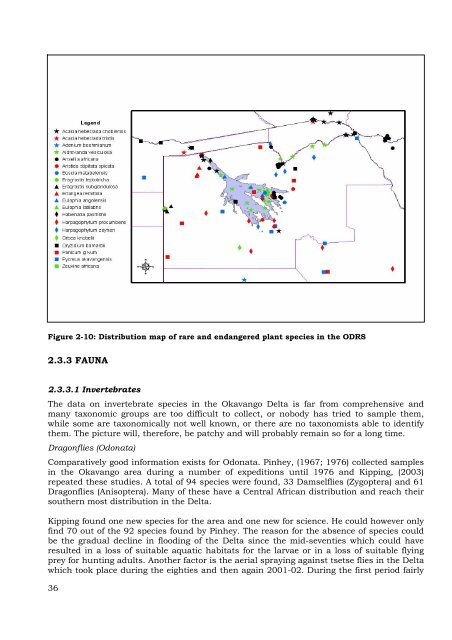Okavango Delta Management Plan - Ramsar Convention on Wetlands
Okavango Delta Management Plan - Ramsar Convention on Wetlands
Okavango Delta Management Plan - Ramsar Convention on Wetlands
Create successful ePaper yourself
Turn your PDF publications into a flip-book with our unique Google optimized e-Paper software.
Figure 2-10: Distributi<strong>on</strong> map of rare and endangered plant species in the ODRS<br />
2.3.3 FAUNA<br />
2.3.3.1 Invertebrates<br />
The data <strong>on</strong> invertebrate species in the <str<strong>on</strong>g>Okavango</str<strong>on</strong>g> <str<strong>on</strong>g>Delta</str<strong>on</strong>g> is far from comprehensive and<br />
many tax<strong>on</strong>omic groups are too difficult to collect, or nobody has tried to sample them,<br />
while some are tax<strong>on</strong>omically not well known, or there are no tax<strong>on</strong>omists able to identify<br />
them. The picture will, therefore, be patchy and will probably remain so for a l<strong>on</strong>g time.<br />
Drag<strong>on</strong>flies (Od<strong>on</strong>ata)<br />
Comparatively good informati<strong>on</strong> exists for Od<strong>on</strong>ata. Pinhey, (1967; 1976) collected samples<br />
in the <str<strong>on</strong>g>Okavango</str<strong>on</strong>g> area during a number of expediti<strong>on</strong>s until 1976 and Kipping, (2003)<br />
repeated these studies. A total of 94 species were found, 33 Damselflies (Zygoptera) and 61<br />
Drag<strong>on</strong>flies (Anisoptera). Many of these have a Central African distributi<strong>on</strong> and reach their<br />
southern most distributi<strong>on</strong> in the <str<strong>on</strong>g>Delta</str<strong>on</strong>g>.<br />
Kipping found <strong>on</strong>e new species for the area and <strong>on</strong>e new for science. He could however <strong>on</strong>ly<br />
find 70 out of the 92 species found by Pinhey. The reas<strong>on</strong> for the absence of species could<br />
be the gradual decline in flooding of the <str<strong>on</strong>g>Delta</str<strong>on</strong>g> since the mid-seventies which could have<br />
resulted in a loss of suitable aquatic habitats for the larvae or in a loss of suitable flying<br />
prey for hunting adults. Another factor is the aerial spraying against tsetse flies in the <str<strong>on</strong>g>Delta</str<strong>on</strong>g><br />
which took place during the eighties and then again 2001-02. During the first period fairly<br />
36

















